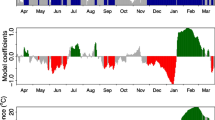Abstract
Tapping-tree density in rubber plantations affects the production of dry rubber. Farmers can estimate rubber productivity when they know with certainty the number of tapping trees within a plantation and can therefore increase productivity through optimized planting schematics. Historical data on planting distance between trees and between rows, planting density (trees/ha) and tapping-tree density (number of trees under tapping for latex harvest per hectare) from 1952 to 2014 have been collected for plantations in the Hainan, Yunnan and Guangdong provinces of South China. A plantation survey was conducted to collect more detailed data on current tapping tree and planting densities in various plantations in the three provinces. Planting density and row spacing are found to have increased with rubber tree planting time and plant spacing to have declined from 1952 to 2014. Tapping-tree density of rubber plantations from 1955 to 1995 in South China ranges from 270 to 345 tree/ha, averaging 300 trees/ha. Strong typhoons and cold snaps are important drivers of fluctuations in tapping-tree density. The factors driving tapping-tree density are similar across the three provinces but the degree of change differs between provinces. Tapping panel dryness (due to tapping beyond the natural limit of the rubber tree productivity), severe wind damage and cold damage are the major factors resulting in loss of tapping trees in plantations in South China. These results suggest that a combination of environmental management for extreme weather and targeted breeding could improve tapping-tree density in rubber plantation and therefore dry rubber yield per unit area.


Similar content being viewed by others
References
Abdullah BS (1985) Planting tree density of smallholdings. World Trop Agric Inf 23(1):18–22
Bauer PT (1946) The economics of planting tree density in rubber growing. Econ N Ser 13(50):131–135
Beria L, Laxman J (2010) Eco-certified natural rubber from sustainable rubber agroforestry in Sumatra, Indonesia. 1–33 http://worldagroforestry.org/content/eco-certified-natural-rubber-sustainable-rubber-agroforests-sumatra-indonesia. 22 Sept 2014/21 May 2015
Binh TN (2013) Large-scale altitudinal gradient of natural rubber production in Vietnam. Ind Crops Prod 41(1):31–40
Dong JW, Xiao XM, Sheldon S, Chandrashekhar B, Xie GS (2012) Mapping tropical forests and rubber plantations in complex landscapes by integrating PALSAR and MODIS imagery. ISPRS J Photogramm Remote Sens 74:20–33
Feintrenie L, Patrice L, Sumatra R (2009) Agroforests: advent, rise and fall of a sustainable cropping system. Small Scale For 8(3):323–335
Huang XQ (2008) Primary analysis of possibility and means of increasing production potential in Hainan State Farm. Chin J Trop Agric Sci 28(5):55–58, 65
Jiang GZ, Yang Y, Su HP, Long JM, Liu CF, He HN, Xiao CY (2009) Investigation on tapping panel dryness in Xishuangbanna. Chin J Sci Technol Trop Agric 32(2):1–5, 13
Li ZQ (2005) Rational thinking after Typhoon “Damrey”. Chin J Hainan State Farm Sci Technol 17(6):1–6
Luo YH, Luo SY, Fu HB (2006) Report of high yielding rubber plantations in Bayi State Farm. Chin J Hainan State Farm Sci Technol 18(1):1–3
Manivong V. (2007) The economic potential for smallholder rubber production in Northern Laos. PhD thesis, The University of Queensland. Brisbane. http://lad.nafri.org.la/fulltext/LAD010320080112.pdf. 12 Jan 2008/21 May 2015
Menz KM and Grist P (1996) Increasing rubber planting tree density to shade imperata: a bioeconomic modelling approach. Agrofor Syst 34(3):291–303
Mo YY, Huang HS (2009) Changes in trade policy and development ideas of natural rubber industry. Chin J Trop Agric China 6(4):8–11
Obouayeba S, Dian K, Boko AMC, Gnagne YM, Ake S (2005) Effect of planting tree density on growth and yield productivity of Hevea brasiliensis Muell. Arg. clone PB 235. J Rubber Res 8(4):257–270
Qiu XJ (2008) Strengthening natural disaster risk prevention system to promote the sustainable development of natural rubber industry. Chin J Hainan State Farm Sci Technol 20(6):9–18
Rodrigo VHL (2007) Ecophysiological factors underpinning productivity of Hevea brasiliensis. Braz J Plant Physiol 19(4):245–255
Rodrigo VHL, Nugawela A, Pathirathna LSS, Waidyanatha UPS, Samaranayake ACI, Kodikara PB, Weeralal JLK (1995) Effect of planting tree density on growth, yield related factors and profitability of rubber (Hevea brasiliensis Muell. Arg.). J Rubber Res Inst Sri Lanka 76:55–71
Rodrigo VHL, Stirling CM, Silva TUK, Pathirana PD (2005) The growth and yield of rubber at maturity is improved by intercropping with banana during the early stage of rubber cultivation. Field Crops Res 91(1):23–33
Setiasih I, Kirsfianti LG, Aneka P, Digby R (2014) Commercialising community forestry in Indonesia: lessons about the barriers and opportunities in central Java. Small Scale For 13(4):515–526
Silva TUK, Subasinqhe S, Rcdrlqo VHL (2006) Rubber latex production in Hevea brasiliensis with high density planting. In: Proceedings of the international forestry and environment symposium 2006 of the Department of Forestry and Environmental Science, University of Sri Jayewardenepura, Sri Lanka, pp 7–8
State Council P. R. China (2008) State Council approved on consent management system reform to promote the views of Hainan State Farms. http://fgk.chinalaw.gov.cn/article/fgxwj/200807/20080700277040.shtml. 09 July 2008/18 May 2015
Tang QY and Feng MG (2009) DPS data processing system: experimental design, statistical analysis, and data mining. Science Press, Beijing
Viswanathan PK (2008) Emerging smallholder rubber farming systems in India and Thailand: a comparative economic analysis. Asian J Agric Dev 5(2):1–19
Wu JL (2005) Fifty years of rubber tree cultivation in Hainan State farms. Chin J Hainan State Farm Sci Technol 17(1):23–43
Acknowledgments
We are thankful to China Agriculture Research System (CARS-34-GW5) for providing financial support. We are grateful to the tropical crop management staff of Hainan, Yunnan and Guangdong provinces for their assistance in the collection of survey data. We are also very appreciative to Steve Harrison for providing helpful edit suggestions. We would also like to thank Alison Beamish at the University of British Columbia for her assistance with English language and grammatical editing of the manuscript.
Author information
Authors and Affiliations
Corresponding authors
Rights and permissions
About this article
Cite this article
Qi, D., Zhou, J., Xie, G. et al. Optimizing Tapping-Tree Density of Rubber (Hevea brasiliensis) Plantations in South China. Small-scale Forestry 15, 61–72 (2016). https://doi.org/10.1007/s11842-015-9308-8
Accepted:
Published:
Issue Date:
DOI: https://doi.org/10.1007/s11842-015-9308-8




